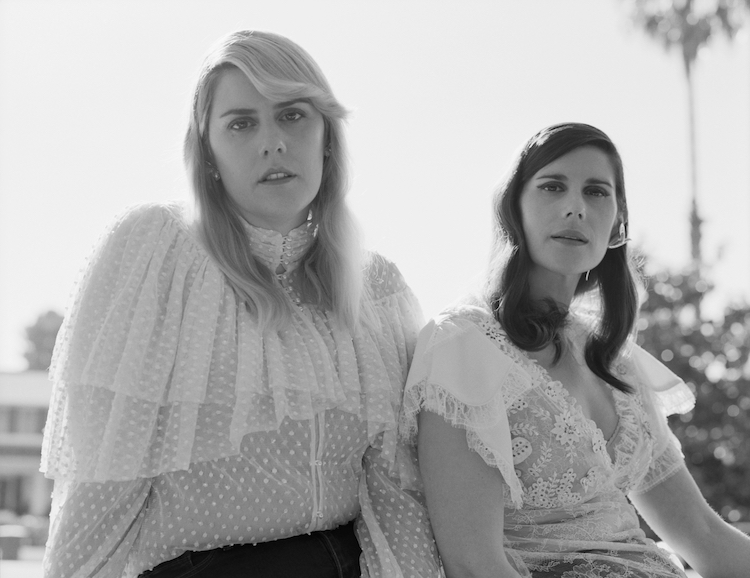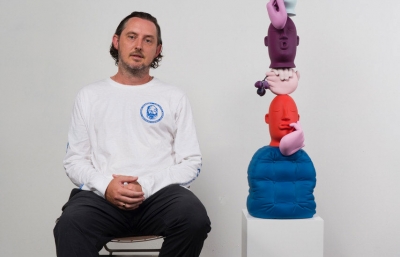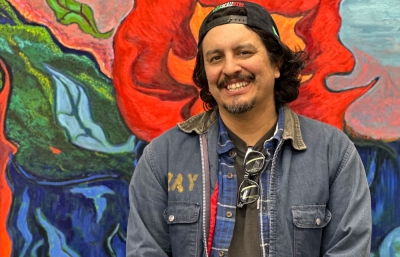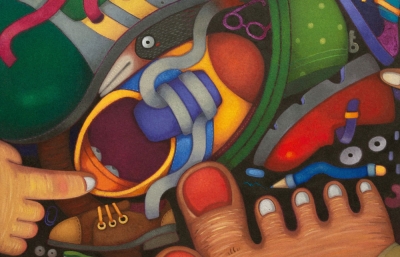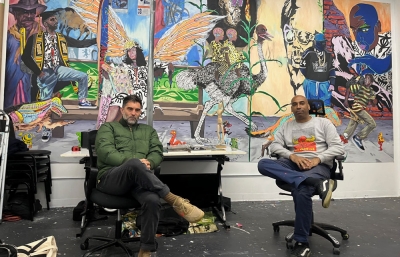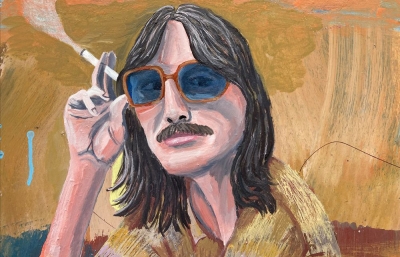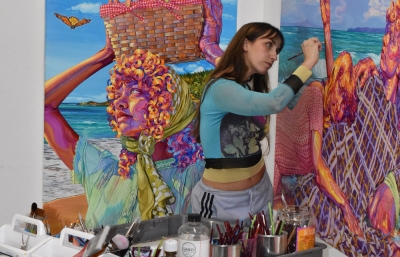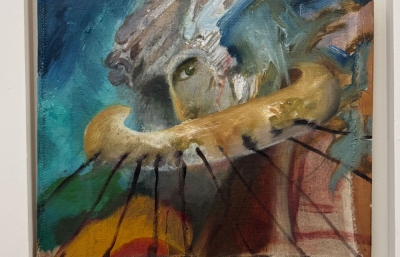Rodarte, at the National Museum of Women in the Arts, is a more majestic drama that what’s currently on display in Washington DC, so well worth a visit before it closes there on February 10th. While the intricate clothing is arranged thematically, each piece begs to be slowly savored for the intricate sculpting, layering and staging. Dresses and leggings are adorned and armed with references to science, film, literature and nature. This is a rare opportunity to spend time with the imaginations of sisters Kate and Laura Mulleavy who are Rodarte.
This interview was originally published in the Winter 2019 issue:
Sierra Madre, which took its name from a Mexican mountain range, is birthplace of the Irish-descended Perry Mulleavy, mycologist and father of Laura and Kate, whose artist mother, Victoria, is of Italian and Mexican descent. Rodarte, the first fashion house to be exhibited at the National Museum of Women in the Arts, and currently on view through February 10, 2019, is Kate and Laura, but more importantly, they are Rodarte. Adopting Victoria’s maiden name for their brand, the sisters channel family, heritage, tradition and the pioneer vision of a California rooted in endless desert and skyward redwoods.
Working with the New York design firm Rafael de Cardenas, 97 fully-realized fashion moods from 13 years of work are presented in tableaux that transcend time and trend. Displayed as they were in the drama of past runway shows, the collection is showcased on fully decked-out mannequins, as well as floating on buoyant physical, invisible mounts. Rings, footwear and floral wreaths perfume and punctuate each design. As Guest curator Jill D’Alessandro emphasized, “They are visual thinkers. This is a very visual exhibition, so it’s ideal to see their pieces in person.”
While pattern-making is an element in their complex designs, and Kate does the sketching, each is intimately involved in making the clothing. Sewing skills learned from their mother are important, but curiosity about materials and how to manipulate them is their hallmark. Hand selected fabrics might be actively distressed, shellacked, dyed, or painted with sand.
A lifetime fascination with film, including its elements of lighting, screenwriting, make-up, music and cinematography, infuse their imagination. Star Wars, My Fair Lady, or Texas Chainsaw Massacre might kindle a fashion concept. For the first official foray into movies, their costume designs for Black Swan became characters in themselves. In their directorial debut, Woodshock, a young woman navigates life and death through the shards of light flickering through deep, dark ancient redwood groves, her black dress shedding shiny sequins, sloughing skin or scattering seeds. For the Rodarte sisters, words and colors configure to tell stories, and many unfold in this fashion exhibit.
The galleries are set up thematically, starting with “Early Innovations,” in examples that illustrate how their unorthodox methods and materials have made such an impact in the fashion world. A roomful of black designs highlights texture and layering. “Magical Beautiful Horror” pays homage to Kate and Laura’s appetite for the horror genre, which, in turn, led to their designs for Black Swan, two of which appear in this show. The “Texture” gallery crackles with their manipulation of material, dying, shredding, papering, sanding and burning. Floral images inspired by Vincent Van Gogh bloom from a remembered visit to the Mount Wilson Observatory in a collection bursting with space and sunspots. “Starry Nights” boasts equal billing to a Star Wars collection, which references one of the sisters’ favorite movies. Romance flutters in “The Garden,” while the Golden State rolls on as a constant influence in “Northern California Roadmap.”
Following their fall, 2018 show at the New York Marble Cemetery, Kate and Laura Mulleavy answered a few questions.
Gwynned Vitello: Almost every profile I’ve read has cited your love of the horror genre, but tell me about other films you treasure, as well as recent viewings that have made an impact.
Kate and Laura: Film is a huge influence on our creative process and work. We have so many favorites: McCabe and Mrs. Miller, Wanda, Vagabond, Three Women, In the Mood for Love, Cries and Whispers, Stalker, Picnic at Hanging Rock, Texas Chainsaw Massacre, Kawaidan, the list could go on and on…
Right now, we would say that Three Women is the biggest inspiration. Sissy Spacek as Pinky Rose, Shelley Duvall as Millie Lamoreaux and Janice Rule as Willy Hart, in combination with the California desert and Bodhi Wind’s murals, make for iconic cinematic imagery and narrative. Strange and wondrous, these characters intermingle almost like a dream. Pinky dressed in her many nightgowns, longing to be anyone but who she is, Millie unpacking her groceries and narrating to herself, and desolate Willy, standing amid her surrealistic pastel murals. Each viewing leads to a new fondness for Altman’s boundless understanding of the cinematic form.
Your mom, an artist, must have been a huge influence.
Our mom is an incredible artist who paints, made beautifully textured wall hangings, and worked in pottery and ceramics. She said that when she was little and visited her family in Mexico, she was exposed to so much craft and artistry that later, as an adult, she wanted to try and do it all.
I know you source your own textiles. Are there fabrics or silhouettes you particularly enjoy using?
We love lace and tulle. We gravitate toward light and airy fabrics that create an ethereal effect.
Besides your studies at Berkeley, Art History for you, Kate, and English Literature in your case, Laura, what was the catalyst for your first collection?
Our father was a botanist, so we were always playing in forests and greenhouses. Our first collection was actually inspired by the forest near to where we grew up, the textures of the redwood trees, and the detailed, magical world of mushrooms.
Location, location, location. Where is your studio, and did you like showing in New York and Paris?
Our studio is in Los Angeles, so we live and work in Southern California. The natural landscape of California is a huge influence on our work. It is truly amazing to show in New York and Paris. They are both incredible cities in terms of history and legacy.
Did you enjoy the process of movie-making? I imagine you spending so much time scouting locations, editing and re-editing. Does it require a lot more collaboration?
We loved making our first movie and cannot wait to make our next. It truly is the biggest creative undertaking in which we’ve taken part, and in a way, the most rewarding. We would meet people who have had such personal reactions after seeing the film, and it was very emotional to exchange thoughts with them about the movie. Often, we found that the themes and meaning of the film were completely subjective, so the conversation became about the viewer’s experience within their own lives. Woodshock became a vehicle for each person to discuss their own specific journey, so this made the dialogue surrounding our first film very intimate.
Is there a particular gallery in the show for which you have a special attachment, that really comes to life?
One of the rooms in the show is inspired by a garden and it is filled with dresses from many different collections, but all inspired by nature and our favorite flowers.
Is it your perception that you each bring an individual strength to the design process, or do you really feel like it’s more an instinctual give and take?
We often have different ideas and challenge each other, but in the end, we always come to a focused and unified viewpoint. It’s an organic and intertwined process. In fact, it’s often difficult to know who thought of what or who made a particular decision!
The National Museum of Women in the Arts, located in Washington, DC, is the only major museum in the world with a mission to advocate women in the arts. Rodarte, the first fashion exhibit to be showcased at NMWA is on view through February 10, 2019.

